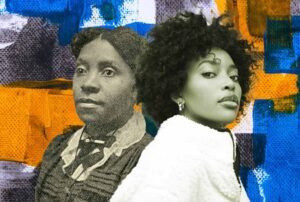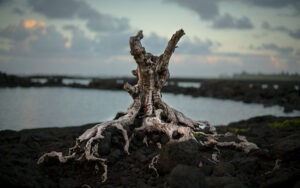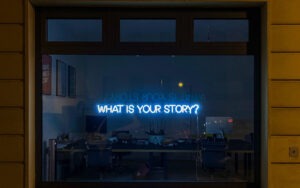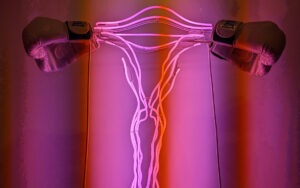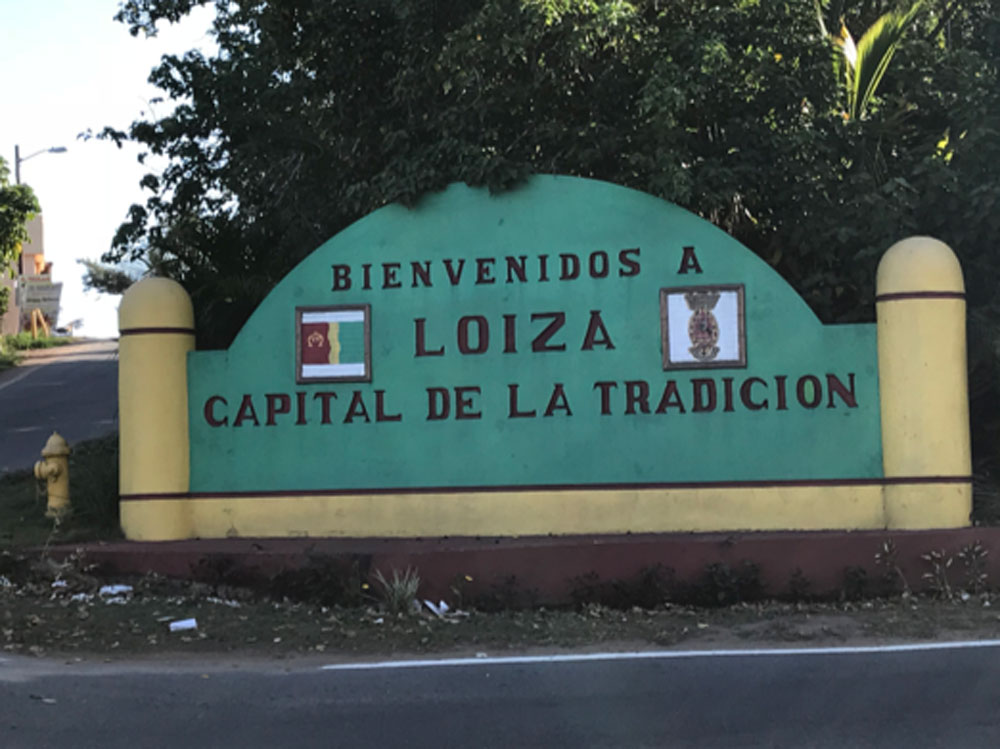
This article was first published on September 4, 2018.
On a recent visit to Puerto Rico, I realized just how much narrative has to do with the challenges the island faces and its response to those. Though it is a fertile land and has a highly educated population and a vibrant, resourceful culture, Puerto Rico is poorer than Mississippi, the poorest US state. Loíza, the blackest municipality in Puerto Rico, is the poorest on the island. A newly forming nonprofit, Caribbean Cultural Corridor, a network of local economies for local Black art, seeks to challenge anti-black narratives on the island, starting in Loíza.
Tatyana Hopkins describes the town in Black Voice News.
Loíza is Puerto Rico’s center for African-inspired traditions and it retains one of the largest Black populations on the island; more than 60 percent of its 30,000 residents identify as Black.
[…]
Known as the “Capital of Traditions,” Loíza is the birthplace of Black Puerto Rican music and is where the dance Plena was born. Bomba music and other African-Taíno infused food and traditions are commonplace here. Loíza artisans produce the colorful coconut masks displayed at festivals and make the unique Bomba drums.
[…]
It began as a place to harbor escaped slaves from Puerto Rico and all over the Caribbean. But, despite its rich culture, Loíza is one of the most impoverished parts of Puerto Rico. Only 20 minutes east of the capital San Juan, Loíza is often overlooked as a tourist destination, even though resorts lie 5–10 minutes east of the river in Rio Grande.
A group of about 30 leaders concerned with racial inequity in Puerto Rico met in Loíza in August to advance the development of the Corridor. The conversation quickly got interesting when the group was asked, “What is your experience of race in Puerto Rico?” Here is what some of them said:
Melanie Rodriguez, university student: “How is it possible that I can’t get a BA in Black Studies without leaving the island?”
Olga Chapman Rivera, business professional: “Our parents moved us out of our black neighborhood because of the crime and drugs, to a white neighborhood and a private white school. We learned to see our roots and something that is not so desirable. The idea was to come out of blackness and out of the ‘hood in order to advance in life. I had to make a journey back.”
Denisse Lanzo Cortijo, social worker and local municipal legislator: “In Loíza, there is negro de [black from] Piñones, negro del [black from] pueblo, negro de Colobos. Even in Loíza, a black town, we divide ourselves.”
Aaron Gamaliel Ramos, university professor: “This doesn’t happen so much with educated blacks. My friend says, ‘You’re black, but you didn’t go through what I went through.’ We differentiate between black and evidently black. How do we talk about blacks? Here we are celebrating black, but out there they do not.”
Modesta Irizarry, community leader: “It’s important to know the story of the towns and communities. How you talk about it as professionals is also different from how we talk about it in the community. People have been displaced to build high-income housing, which is still empty. Because of the hurricane, this is easier. They got very little for their land, being treated as blacks. The government doesn’t care about Loíza. Why don’t they build livable housing for the people already here? We are not just culture, we are valuable as people. I asked a government official, why not give me one of the three new buildings for the people of Tocones, and he said, ‘We can’t do that.’ I said, ‘You can’t do that because it doesn’t benefit you as a corrupt politician, but it can be done.’ You’re not better than me. I even say that to well-off blacks. The trash here is not thrown out by the blacks of Loíza, but the visitors who think they can trash our neighborhood. A black cop will say, ‘Get down on the dirt negra [black woman].’ ‘Spread your legs negra.’ It’s not just about valuing blackness, but valuing nature.”
Maria Elba Torres Muñoz, university professor: “Blackness in Loíza is different because you are together, but there are blacks everywhere in the island and many of them are isolated as blacks.”
The tensions were evident within the group. Very clearly and early on, the differences between the mostly black leaders were named. These include differences of class, education level, and geography. They reveal the fractal nature of oppression, where the patterns are similar across scale. For example, during the lunch that followed, a small group of women from Tocones, one of the poorest neighborhoods in Loíza, wanted to tell me their story of their marginalization within Loíza. They didn’t feel comfortable sharing it explicitly within the larger group.
Alicia Carrasquillo Ortiz, who describes herself as a Second Community Leader, says, “In Tocones, it’s like we don’t exist. I scheduled three meetings with the mayor and she has cancelled them all. I waited all day in the office, but she never came. I bring simple questions from the community. She isn’t interested. For example, the sewer system erupts in front of our house leaving black waters [contaminated sewer water] where kids play, and they don’t fix it. It’s not even our sewer system, but from the new luxury apartments on either side of us, Aquatika and Costa Mar. Many of the residents are local whites from other towns. Apartments in Aquatika start at $200,000.”
Issues of racism, economic displacement, and narrative interlock. Moreno Vega speaks to it when she says, “Displacement of black people is happening everywhere around the world. So, the idea of this Corridor is to establish the places of historical importance in Loíza, that it be from an Afro-centered view, to determine the narrative and imagery.”
The proposed Corridor would run along Loíza 187, one of the main roads. It would indicate the historic places of the town and illustrate how it was created by runaway slaves. It would also showcase two art destinations featuring the most notable local artists. Artesanías Castor Ayala is a small gallery opened in 1959 by Castor Ayala, who was my grand-uncle and raised my mother. A quick online search for more information about the gallery brings me to TripAdvisor and other tourist reviews, and this from Puerto Rico Day Trips:
This little yellow “store” is hard to miss—it is decorated inside and out with beautiful coconut Vejigante masks. Vejigante are traditional figures used in the local celebrations (namely, the annual Saint James Festival in July). They are elaborately dressed with brilliantly-colored costumes, and scary-looking carved coconut shell masks, with long pointy horns.
Raul Ayala, with help of the rest of the family, continues the legacy of coconut mask carving that the Ayalas are known for. The family also is famous for their local Bomba music and dance (Ballet Folklórico Hermanos Ayala).
[…]
I was surprised at how reasonably priced the masks were. You can get a hand-carved half mask for about $30, and the whole masks start at about $75 and go up (depending on how elaborate they are). Each mask is hand-carved and painted, and signed by the artist. In addition to their masks, they also have a few other types of handcrafted souvenirs.
Through this website, one can find the family’s Facebook page, which posts pictures and otherwise showcases events but doesn’t tell you much about who they are or the cultural role they play.
Also featured is Samuel Lind Studios, the live-and-work space of a very well-known painter and sculptor. He is also an Ayala through maternal lineage; these families have influenced each other artistically and are known as stewards of local African history, wisdom, and aesthetics. It is easy to spend a day with Samuel listening to his passionate stories about the great singers who visit him to learn about this heritage and weave it into now-famous songs, like Héctor Lavoe, or the indigenous and relatively unknown people who still live in the mangrove in Loíza. It’s as if no one told these families that blackness is looked down upon, and that’s all for the best. I have always experienced them as loving, humble, and noble, and consider myself blessed to have grown up in such a family where anti-blackness was not present.
Puerto Rico Day Trips describes the studio this way, continuing from the above description:
Sign up for our free newsletters
Subscribe to NPQ's newsletters to have our top stories delivered directly to your inbox.
By signing up, you agree to our privacy policy and terms of use, and to receive messages from NPQ and our partners.
Just a couple 100 yards away, down the small side street to the north, you will find Samuel Lind Studio. This 2-story wooden house is beautifully covered with flowering plants, and is home to Samuel Lind’s working studio and art gallery. As you walk inside, you are almost overwhelmed by the colors and beauty of the art. His work is mainly inspired by his life in Loíza, its nature, people, beauty and heritage.
[…]
If you have been to the Botanical Garden in Caguas, you have already seen one piece of Lind’s work—he made the huge bronze sculpture displayed in the African section of the garden.
[…]
Most of the works in his studio/gallery are for sale, and range in price to very reasonable for lithographs/posters up to big bucks for original paintings and bronze sculptures.
Lind also doesn’t have a website, but, like the Ayalas, he has a Facebook page where he posts his work and describes his approach and inspiration.
An online search for things to do in Loíza quickly reveals other destinations. The Hacienda Campo Rico Heritage Tour takes the visitor to a former sugar cane plantation. Piñones, Puerto Rico’s largest mangrove forest, is near Loíza Beach, which is lined with Afro-Caribbean food kiosks. The Maria de La Cruz Cave, “an enormous formation of limestone origin, whose measurements are 164 feet wide, 82 deep and 98 high, is one of the 72 archaeological sites documented in Loíza, according to the State Office of Historic Conservation.” Ricardo E. Algeria, a Puerto Rican anthropologist and archaeologist known as “father of modern Puerto Rican archeology, excavated the cave to great fanfare.
“Beneath the surface of the cave, Alegría excavated polished stone tools, some small flakes carved from flint, pieces of red ocher, an abundance of food remains, mostly marine and terrestrial mollusks, as well as crab levers. He also recovered a human burial in an extended position. Alegría baptized the culture representative of these remains as the Archaic Culture, because it is the oldest indigenous culture found in Puerto Rico,” said archaeologist Miguel Rodríguez López, rector of the Center for Advanced Studies of Puerto Rico and the Caribbean (CEA), to EL VOCERO.
Yale published a book by Alegria on the excavations.
As these anecdotes and descriptions demonstrate, there is already a sense of the historical and cultural richness of Loíza, but its creators and stewards don’t benefit economically from it. The Corridor seeks to better organize these artists and stewards and link them to one another to help build a more viable and equitable local economy. It will build on the work of COPI [La Corporación Piñones Se Integra, or Piñones Integration Corp.], which focuses on cultural and ecotourism, by providing workshops on conscious tourism, as opposed to exploitative tourism.
Edgardo Larregui, a designer on the Corridor project, says, “We don’t want the banal cliché, what is sold to us as the concept of beaches and tropics, coasts and coconuts. Instead, it’s, ‘What do we do with our raw materials?’ ‘How do we create those raw materials into deities, identities?’”
Dr. Marta Moreno Vega is the visionary behind the Caribbean Cultural Corridor. New York born and raised, she found her way back to the island early on and has spent the last four decades connecting to local black artists and thinkers and promoting their work. She has already identified the building she intends to purchase for the project—a beautiful, abandoned, two-floor structure that sits high on a perch. It is available through foreclosure and needs repair, but it is easy to imagine it as the center of a Caribbean-wide cultural network, as Moreno Vega and her collaborators do.
The Corridor is also an example of new approaches by stateside nonprofits like the Association of Black Foundation Executives (ABFE), which is expanding its work to the black diaspora. ABFE partnered with the Community Foundation of Puerto Rico (Fundación Comunitaria de Puerto Rico), which is leading the philanthropic work on equity on the island and exploring how to support more explicitly its racial aspects, to host this gathering to build awareness of, solicit feedback for, and build support for the Corridor. The response was a resounding yes.
A few days later, the collaboration leaders met at the Community Foundation of Puerto Rico to debrief the gathering and accompanying activities and identify possible solutions.
Maricruz Rivera Clemente, COPI’s Executive Director, had just gotten back from New Orleans, where she and Mercedes Martinez, President of the Puerto Rico Teachers Federation, met with a group that had visited Puerto Rico in October of last year that is also fighting the closing and privatization of their schools. Rivera Clemente says,
We were sharing about the things we have in common after the hurricanes. The similarities are a lot. Some women in New Orleans were talking about their experiences of leaving to other cities, where they were called refugees. And they said, “We’re on our land.” And when they went back [to New Orleans], they didn’t have the same structures. Things were different…the privatization of the schools. Now the teachers weren’t black. They came from other places and didn’t know the cultures of the community. The same thing is happening in Puerto Rico. In Piñones and Loíza, when Maria came, the department of education closed the schools immediately. We’ve known that they want to close the schools for a long time now; the excuse for the government was Maria.
Rivera Clemente also spoke of the issue of violence, “Young black kids are killing young black kids. We are killing ourselves. So we have to work on that, but not in the way the government wants to work with the violence. Since slavery, we have learned to fight against each other.”
Perhaps one major cause of the violence in Loíza is the high unemployment rate. Though a report by the Commonwealth of Puerto Rico, Department of Labor and Human Resources, Bureau of Labor Statistics for 2015-2016 lists unemployment in Loíza at 11.4 percent, this was before Hurricane Maria. Local municipal legislator Denisse Lanzo Cortijo, who was present at the gathering, said the numbers are closer to 70 percent. So, since the storm, most people in Loíza are unemployed.
As the group turned to solutions, it quickly became clear that Puerto Rico does not track race rigorously. In fact, people self-identify their race and many choose to whiten their identity. In the 2010 Census, 12.4 percent of the population identified as Black and 75.8 percent as white. Mary Ann Gabino, Senior Vice President at the Community Foundation, proposed academic scholarships to support the study of data on racial equity, which would help identify gaps and generate solutions.
Recalling the underlying tension between academics and community people at the gathering, Moreno Vega spoke to the need to act now, with on-the-ground solutions identified and led by the people and that generate employment for them. She says,
There’s so much talent in Loíza and no one is paying attention to it. In lifting that, we should train people so they can become entrepreneurs. We always see ourselves as limited. We have young people doing music speaking through the narrative. Training young people in the narrative of culture and empowerment is powerful.
And with this we come back to narrative, because the underlying and unacknowledged racism hampers current economic development efforts. Rivera Clemente explains, “For example, Piñones, with its culinary kiosks, is a culinary space, but what does the state do? It penalizes the community business by being very slow to provide permits. They make it difficult for people to create businesses. The children of the families aren’t encouraged to keep building the businesses.”
Puerto Rico has its own well-worn tactics for tabling race when it is made explicit. Musician Welmo Romero Joseph says, “If you try to bring it up, people say we are all equal, it’s more important to talk about colonialism and our status with the US. When we solve that, all the problems will disappear. They say the problem is that we have an inferiority complex.”
Because this devaluation is built into, or expunged, from the narrative, it appears everywhere, and can feel overwhelming for black people, who can feel like they’re playing a cruel game of whack-a-mole. Romero Joseph says, “There’s so many fronts to fight, you have education, history, media, work…They want black culture, but not black people.”
Art flourishes in Puerto Rico, and there are already groups like Colectivo Morivivi, a collective of young women artists that has gained recognition for their murals, which aim to sensitize the viewer to the human condition. Much of its work features black Puerto Rican women. There is a lot to build on, connect, and amplify.
Institutional power helps, which is why Moreno Vega seeks to build the Corridor. Rivera Clemente says, “Support is not just money, but credibility.”
In spite of the spread of anti-black narratives, Moreno Vega would argue that is precisely because of that that narrative work is critical, especially now. She concludes, “Pathology and lies are becoming normalized. This conversation is so upfront, deadly, and targeted. We can’t accept that as normal. That you’re the lone wolf saying it makes you a target. What’s the interdisciplinary action that one takes to normalize our narrative?”



